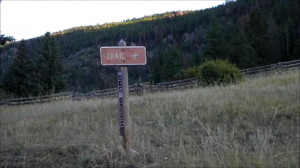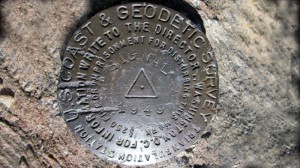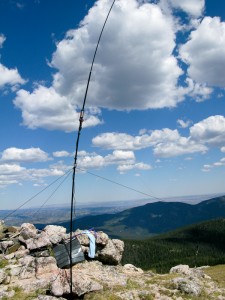Signal Mountain (WØC/FR-127) can be reached from the Dunraven trailhead from the south, or from Pingree Park Road from the north. If you are lucky enough to have a shuttle driver, it makes a great 11+ mile hike from the north fork of the Big Thompson River all the way to the Poudre River. The peak is located at the north-east end of the Mummy Range in the Comanche Peak Wilderness which is part of the Roosevelt National Forest. The summits of Signal Mountain – as well as nearby West Signal – are pushing well above the treeline and thus provide unobstructed 360 degree views. The weather forecast was excellent (it cooled down quite a bit) and I was joined by my best trail-buddy, friend and wife – making this a great anniversary hike.
Trailhead: 7828 ft / 2386 m
Summit: 11262 ft / 3432 m
Elev. gain: 4064 ft / 1239 m
Roundtrip: 11.7 mi / 18.8 km
Compare this summit with my other activated summits
How to get there:
Take US34 from Loveland towards Estes Park through Big Thompson Canyon. When you pass through Drake, take a right on CR43 along the north-fork (scenic). Take a right on Dunnraven Glade Road (dirt road) which follows the north-east flank of Triangle Mountain. You can’t miss the parking lot since it is the end of the (public) road. A private road continues behind a locked gate all the way to Trails End Ranch.
Parking/Trailhead
View Larger Map
Red Tape:
Nothing comes to mind – rules of the Roosevelt National Forest apply.
The Ascent:
The official trail-head is about half a mile from the parking lot, following the fairly steep
private road after a locked gate towards Trails End Ranch. Shortly before you enter the ranch, the trail-head is clearly marked on your right side with the usual map/posters etc. From here, the trail climbs up the steep hillside to Bulwark Ridge through open terrain. After reaching the ridge, you have some good views to several nearby SOTA peaks such as Triangle Mountain (WØC/FR-Ø82), Crosier Mountain (WØC/FR-Ø57), West Crosier (WØC/FR-Ø64) and even more looking towards Estes Park and the Rocky Mountain National Park (RMNP). Shortly after, the trail intersects with the Indian and Miller Fork trails. Taking the north-west route – following Bulwark Ridge – will lead to Signal Mountain through mostly forested area over a very well established trail. The treeline will be reached after about 3.5 miles, offering great views towards north/north-east.
The Summit:
The summit can be reached by crossing over the fragile tundra-like flora from the trail at the highest point before it leads back down on the other side towards Pingree Park. It is a large, barren, rocky and wind-swept summit with a small stone shelter at the very top where the summit-register is ‘hidden’. The summit is large enough for several SOTA teams if necessary… luckily nobody else was encountered during the whole trip. The views are unobstructed and stunning in all directions.
The weather was just perfect, with a few white and puffy clouds which provided a nice contrast on the blue sky. The setup was easy since space was not an issue and all the rocks lying around helped me with guying the mast in this windy environment . It was my first time with the newly acquired shock-corded mast from Buddipole. I really like the reduced weight of it but it requires a different technique to set it up and to change bands. All the ‘training’ in my backyard helped and I was on the air in no time. It was my first week-end activation and getting QSOs was definitely easier than on all my prior outings, even-though the propagation conditions were not necessarily better than before – at least that is my theory and I am sticking to it.
The Descent:
If you arranged for a shuttle in Pingree Park, you might enjoy a different route, but for us it was the same route back to the car.
Some video impressions:
If you would like to leave questions or comments, please do so through Youtube.
I activated this summit again on May 5th, 2012. You can find the trip-report right here:
![]() !! WARNING !! There are old mountaineers, and
bold mountaineers... there are no old-bold mountaineers.
Hiking and mountain climbing are potentially hazardous activities particularly in Colorado with its extreme elevations. I am not accepting responsibility for any death or injury resulting from activations based on my trip reports. Proper training, experience, and personal capability assessment is required - enjoy!
!! WARNING !! There are old mountaineers, and
bold mountaineers... there are no old-bold mountaineers.
Hiking and mountain climbing are potentially hazardous activities particularly in Colorado with its extreme elevations. I am not accepting responsibility for any death or injury resulting from activations based on my trip reports. Proper training, experience, and personal capability assessment is required - enjoy!
















[..YouTube..] beautiful landscape! Hope for a S2S anytime. 73 Mario dc7ccc / wØccc
beautiful landscape! Hope for a S2S anytime. 73 Mario dc7ccc / wØccc
[..YouTube..] It sure is beautiful up here – Looking forward to a S2S QSO
It sure is beautiful up here – Looking forward to a S2S QSO
[..YouTube..] Awesome. Keep ’em coming. If I may inquire about your antenna set-up. I too use a BP shock cord mast. How did you mount the velcro strap on the mast to guy? It appears you are using a 8′ SC mast, versatee, 1-22″ arm and long whip?? Tuning by ear? 73
Clarence KI4WTT
Awesome. Keep ’em coming. If I may inquire about your antenna set-up. I too use a BP shock cord mast. How did you mount the velcro strap on the mast to guy? It appears you are using a 8′ SC mast, versatee, 1-22″ arm and long whip?? Tuning by ear? 73
Clarence KI4WTT
[..YouTube..] Is the wind a problem for voice communications?
How do you deal with it?
Is the wind a problem for voice communications?
How do you deal with it?
[..YouTube..] Great video. Does the Powerfilm solar panel have the capacity to directly power the FT-817?
Great video. Does the Powerfilm solar panel have the capacity to directly power the FT-817?
[..YouTube..] Another great video. As Mario (DC7CCC) i do hope s2s and why not a both video as Mario and i:
73 QRO
Roger
Another great video. As Mario (DC7CCC) i do hope s2s and why not a both video as Mario and i:
73 QRO
Roger
[..YouTube..] @TUFFMATE thanks for your comments and YEP, you are correct with all you assumptions regarding the antenna. To mount the velcro strap for the guying kit I added a rubber grommet I bought at the local Ace-Hardware store. Just take off the rubber foot from the mast and try the different grommets they have. Mine stays put, no matter what and it does not interfere with the folded mast. Hope it makes sense, otherwise let me know and I will take some pictures for you.
[..YouTube..] thanks for your comments and YEP, you are correct with all you assumptions regarding the antenna. To mount the velcro strap for the guying kit I added a rubber grommet I bought at the local Ace-Hardware store. Just take off the rubber foot from the mast and try the different grommets they have. Mine stays put, no matter what and it does not interfere with the folded mast. Hope it makes sense, otherwise let me know and I will take some pictures for you.
thanks for your comments and YEP, you are correct with all you assumptions regarding the antenna. To mount the velcro strap for the guying kit I added a rubber grommet I bought at the local Ace-Hardware store. Just take off the rubber foot from the mast and try the different grommets they have. Mine stays put, no matter what and it does not interfere with the folded mast. Hope it makes sense, otherwise let me know and I will take some pictures for you.
[..YouTube..] @backpackinonline So far I was always sheltered from the wind to a certain degree, which made it possible to have ‘normal’ QSOs. I just came back from another activation and boy was it windy and cold. I had to crank up the volume as far as possible to be able to read the other side and had to shout into the mike – I had no shelter available on this mountain. Check back soon for the upcoming video of this trip to get an idea about the wind.
[..YouTube..] So far I was always sheltered from the wind to a certain degree, which made it possible to have ‘normal’ QSOs. I just came back from another activation and boy was it windy and cold. I had to crank up the volume as far as possible to be able to read the other side and had to shout into the mike – I had no shelter available on this mountain. Check back soon for the upcoming video of this trip to get an idea about the wind.
So far I was always sheltered from the wind to a certain degree, which made it possible to have ‘normal’ QSOs. I just came back from another activation and boy was it windy and cold. I had to crank up the volume as far as possible to be able to read the other side and had to shout into the mike – I had no shelter available on this mountain. Check back soon for the upcoming video of this trip to get an idea about the wind.
[..YouTube..] @Canzona01 Yes and No. I would NOT recommend to charge the FT-817 directly from any solar panel. In my case, the panel can deliver up to 19V which is (as far as I know) too much for the FT-817. You should use a solar charge controller which keeps the voltage within safe parameters. I am charging an external battery which can handle the 19V from the solar panel. The FT-817 is connected to the external battery. One of my other videos explains my setup.
[..YouTube..] Yes and No. I would NOT recommend to charge the FT-817 directly from any solar panel. In my case, the panel can deliver up to 19V which is (as far as I know) too much for the FT-817. You should use a solar charge controller which keeps the voltage within safe parameters. I am charging an external battery which can handle the 19V from the solar panel. The FT-817 is connected to the external battery. One of my other videos explains my setup.
Yes and No. I would NOT recommend to charge the FT-817 directly from any solar panel. In my case, the panel can deliver up to 19V which is (as far as I know) too much for the FT-817. You should use a solar charge controller which keeps the voltage within safe parameters. I am charging an external battery which can handle the 19V from the solar panel. The FT-817 is connected to the external battery. One of my other videos explains my setup.
[..YouTube..] Thanks for your reply. Absolutely no rush but a photo of the grommet would be great. I really like my SC mast. The option of guying the mast instead of or in addition to the VersaTee would be great. Heading to Glacier NP in a couple of weeks and may have time for a SOTA activation or two.
Clarence KI4WTT
Thanks for your reply. Absolutely no rush but a photo of the grommet would be great. I really like my SC mast. The option of guying the mast instead of or in addition to the VersaTee would be great. Heading to Glacier NP in a couple of weeks and may have time for a SOTA activation or two.
Clarence KI4WTT
[..YouTube..] Thanks for the reply – my initial impression was that that the panel had a built-in voltage regulator but visiting the Powerfilm website I see that the user has to provide that for voltage limiting. You are correct about the FT-817, it is recommended to keep the voltage limited to 12V max.
Thanks for the reply – my initial impression was that that the panel had a built-in voltage regulator but visiting the Powerfilm website I see that the user has to provide that for voltage limiting. You are correct about the FT-817, it is recommended to keep the voltage limited to 12V max.
[..YouTube..] @TUFFMATE Photos sent by e-mail
[..YouTube..] Photos sent by e-mail
Photos sent by e-mail
[..YouTube..] Excellent!
73 de Fred
Excellent!
73 de Fred
[..YouTube..] @DL9MDI Thanks Fred :)
[..YouTube..] Thanks Fred :)
Thanks Fred :)
Pingback: WØ/FR-127 (Signal Mountain) – 2nd activation | KØMOS's SOTA outings
Great Video 73 !!